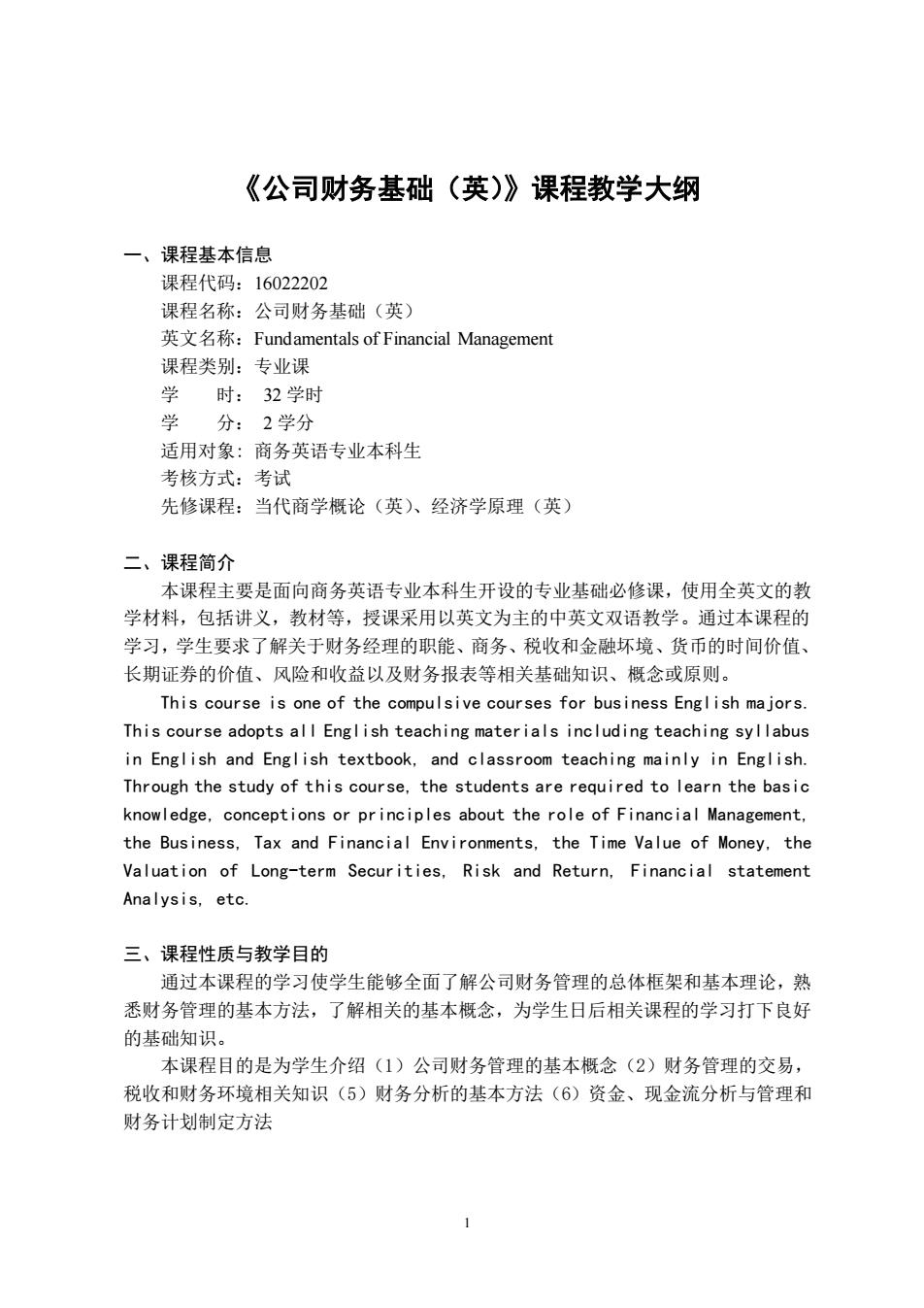
《公司财务基础(英)》课程教学大纲 一、课程基本信息 课程代码:16022202 课程名称:公司财务基础(英) 英文名称:Fundamentals of Financial Management 课程类别:专业课 学 时:32学时 学 分:2学分 适用对象:商务英语专业本科生 考核方式:考试 先修课程:当代商学概论(英)、经济学原理(英) 二、课程简介 本果程主要是面向商务英语专业本料生开设的专业基础必修果,使用全英文的教 学材料,包括讲义,教材等,授课采用以英文为主的中英文双语教学。通过本课程的 学习,学生要求了解关于财务经理的职能、商务、税收和金融坏境、货币的时间价值、 长期证券的价值、风险和收益以及财务报表等相关基础知识、概念或原则。 This course is one of the compulsive courses for business English majors This course adopts all English teaching materials including teaching syllabus in English and English textbook.and classroom teaching mainly in English Through the study of this course.the students are required to learn the basic knowledge.conceptions or principles about the role of Financial Management. the Business,Tax and Financial Environments,the Time Value of Money.the Valuation of Long-term Securities.Risk and Return.Financial statement Analysis.etc. 三、课程性质与教学目的 通过本课程的学习使学生能够全面了解公司财务管理的总体框架和基本理论,熟 悉财务管理的基本方法,了解相关的基本概念,为学生日后相关课程的学习打下良好 的基础知识。 本课程目的是为学生介绍(1)公司财务管理的基本概念(2)财务管理的交易, 税收和财务环境相关知识(⑤)财务分析的基本方法(6)资金、现金流分析与管理利 财务计划制定方法
1 《公司财务基础(英)》课程教学大纲 一、课程基本信息 课程代码:16022202 课程名称:公司财务基础(英) 英文名称:Fundamentals of Financial Management 课程类别:专业课 学 时: 32 学时 学 分: 2 学分 适用对象: 商务英语专业本科生 考核方式:考试 先修课程:当代商学概论(英)、经济学原理(英) 二、课程简介 本课程主要是面向商务英语专业本科生开设的专业基础必修课,使用全英文的教 学材料,包括讲义,教材等,授课采用以英文为主的中英文双语教学。通过本课程的 学习,学生要求了解关于财务经理的职能、商务、税收和金融坏境、货币的时间价值、 长期证券的价值、风险和收益以及财务报表等相关基础知识、概念或原则。 This course is one of the compulsive courses for business English majors. This course adopts all English teaching materials including teaching syllabus in English and English textbook, and classroom teaching mainly in English. Through the study of this course, the students are required to learn the basic knowledge, conceptions or principles about the role of Financial Management, the Business, Tax and Financial Environments, the Time Value of Money, the Valuation of Long-term Securities, Risk and Return, Financial statement Analysis, etc. 三、课程性质与教学目的 通过本课程的学习使学生能够全面了解公司财务管理的总体框架和基本理论,熟 悉财务管理的基本方法,了解相关的基本概念,为学生日后相关课程的学习打下良好 的基础知识。 本课程目的是为学生介绍(1)公司财务管理的基本概念(2)财务管理的交易, 税收和财务环境相关知识(5)财务分析的基本方法(6)资金、现金流分析与管理和 财务计划制定方法
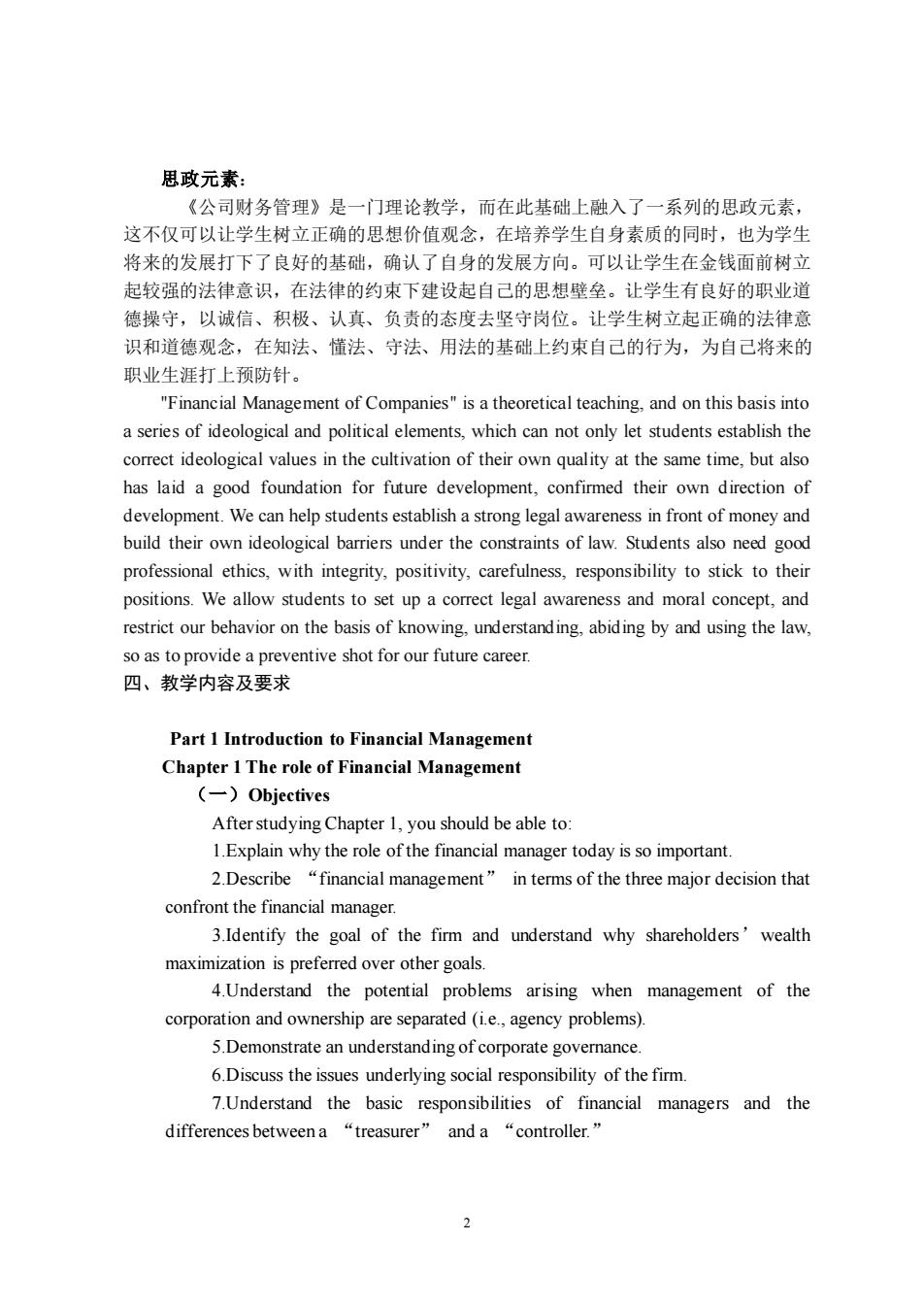
思政元素 《公司财务管理》是一门理论教学,而在此基础上融入了一系列的思政元素 这不仅可以让学生树立正确的思想价值观念,在培养学生自身素质的同时,也为学生 将来的发展打下了良好的基础,确认了自身的发展方向。可以让学生在金钱面前树立 起较强的法律意识,在法律的约束下建设起自己的思想壁垒。让学生有良好的职业道 德操守,以诚信、积极、认真、负责的态度去坚守岗位。让学生树立起正确的法律意 识和道德观念,在知法、懂法、守法、用法的基础上约束自己的行为,为自己将来的 职业生涯打上预防针。 "Financial Management of Companies"is a theoretical teaching,and on this basis into a series of ideological and political elements,which can not only let students establish the correct ideological values in the cultivation of their own quality at the same time,but also has laid a good foundation for future development.confirmed their own direction of development.We can help students establish a strong legal awareness in front of money and build their own ideological barriers under the constraints of law.Students also need good professional ethics,with integrity,positivity,carefulness,responsibility to stick to their positions.We allow students to set up a correct legal awareness and moral concept,and restrict our behavior on the basis of knowing.understanding.abiding by and using the law so as to provide a preventive shot for our future career. 四、教学内容及要求 Part 1 Introduction to Financial Management Chapter 1 The role of Financial Management (一)Objectives After studying Chapter 1,you should be able to: 1.Explain why the role of the financial manager today is so important. 2.Describe "financial management"in terms of the three major decision that confront the financial manager. 3.Identify the goal of the firm and understand why shareholders'wealth maximization is preferred over other goals. 4.Understand the potential problems arising when management of the corporation and ownership are separated (i.e.,agency problems) 5.Demonstrate an understanding of corporate governance 6.Discuss the issues underlying social responsibility of the firm. 7.Understand the basic responsibilities of financial managers and the differences betweena“treasurer”anda“controller.” 2
2 思政元素: 《公司财务管理》是一门理论教学,而在此基础上融入了一系列的思政元素, 这不仅可以让学生树立正确的思想价值观念,在培养学生自身素质的同时,也为学生 将来的发展打下了良好的基础,确认了自身的发展方向。可以让学生在金钱面前树立 起较强的法律意识,在法律的约束下建设起自己的思想壁垒。让学生有良好的职业道 德操守,以诚信、积极、认真、负责的态度去坚守岗位。让学生树立起正确的法律意 识和道德观念,在知法、懂法、守法、用法的基础上约束自己的行为,为自己将来的 职业生涯打上预防针。 "Financial Management of Companies" is a theoretical teaching, and on this basis into a series of ideological and political elements, which can not only let students establish the correct ideological values in the cultivation of their own quality at the same time, but also has laid a good foundation for future development, confirmed their own direction of development. We can help students establish a strong legal awareness in front of money and build their own ideological barriers under the constraints of law. Students also need good professional ethics, with integrity, positivity, carefulness, responsibility to stick to their positions. We allow students to set up a correct legal awareness and moral concept, and restrict our behavior on the basis of knowing, understanding, abiding by and using the law, so as to provide a preventive shot for our future career. 四、教学内容及要求 Part 1 Introduction to Financial Management Chapter 1 The role of Financial Management (一)Objectives After studying Chapter 1, you should be able to: 1.Explain why the role of the financial manager today is so important. 2.Describe “financial management” in terms of the three major decision that confront the financial manager. 3.Identify the goal of the firm and understand why shareholders’wealth maximization is preferred over other goals. 4.Understand the potential problems arising when management of the corporation and ownership are separated (i.e., agency problems). 5.Demonstrate an understanding of corporate governance. 6.Discuss the issues underlying social responsibility of the firm. 7.Understand the basic responsibilities of financial managers and the differences between a “treasurer” and a “controller
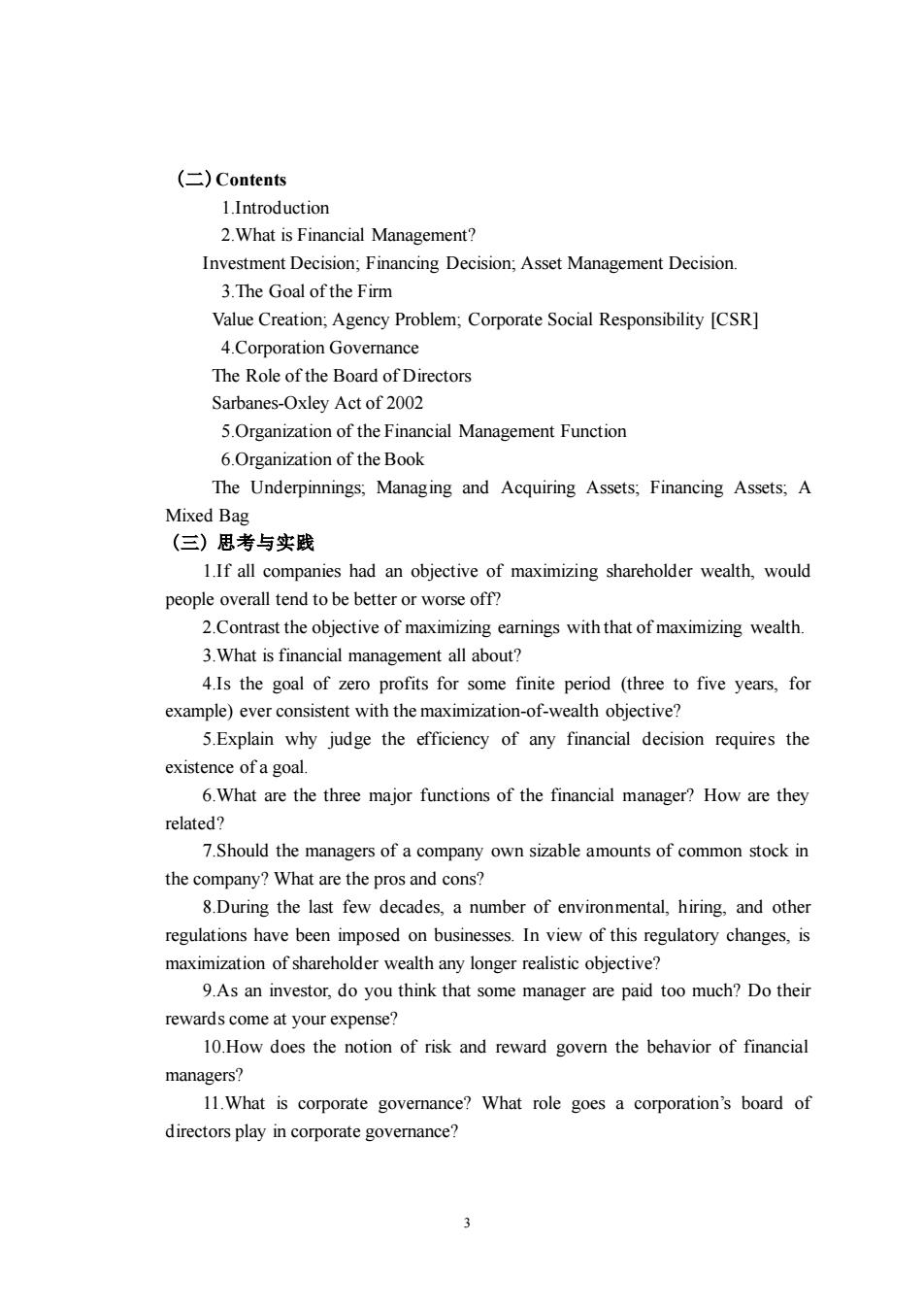
(二)Contents 1.Introduction 2.What is Financial Management? Investment Decision:Financing Decision;Asset Management Decision. 3 The Goal ofthe Firm Value Creation;Agency Problem;Corporate Social Responsibility [CSR] 4.Corporation Governance The Role of the Board of Directors Sarbanes-Oxley Act of 2002 5.Organization of the Financial Management Function 6.Organization of the Book The Underpinnings,Managing and Acquiring Assets;Financing Assets;A Mixed Bag (三)思考与实践 1.If all companies had an objective of maximizing shareholder wealth,would people overall tend to be better or worse off? 2.Contrast the objective of maximizing eamings with that of maximizing wealth 3.What is financial management all about? 4.Is the goal of zero profits for some finite period (three to five years,for example)ever consistent with the maximization-of-wealth objective? 5.Explain why judge the efficiency of any financial decision requires the existence ofa goal. 6.What are the three major functions of the financial manager?How are they related? 7.Should the managers of a company own sizable amounts of common stock in the company?What are the pros and cons? 8.During the last few decades,a number of environmental,hiring,and other regulations have been imposed on businesses.In view of this regulatory changes,is maximization of shareholder wealth any longer realistic objective? 9.As an investor,do you think that some manager are paid too much?Do their rewards come at your expense? 10.How does the notion of risk and reward govern the behavior of financial managers? 11.What is corporate govemance?What role goes a corporation's board of directors play in corporate govemance? 3
3 (二)Contents 1.Introduction 2.What is Financial Management? Investment Decision; Financing Decision; Asset Management Decision. 3.The Goal of the Firm Value Creation; Agency Problem; Corporate Social Responsibility [CSR] 4.Corporation Governance The Role of the Board of Directors Sarbanes-Oxley Act of 2002 5.Organization of the Financial Management Function 6.Organization of the Book The Underpinnings; Managing and Acquiring Assets; Financing Assets; A Mixed Bag (三) 思考与实践 1.If all companies had an objective of maximizing shareholder wealth, would people overall tend to be better or worse off? 2.Contrast the objective of maximizing earnings with that of maximizing wealth. 3.What is financial management all about? 4.Is the goal of zero profits for some finite period (three to five years, for example) ever consistent with the maximization-of-wealth objective? 5.Explain why judge the efficiency of any financial decision requires the existence of a goal. 6.What are the three major functions of the financial manager? How are they related? 7.Should the managers of a company own sizable amounts of common stock in the company? What are the pros and cons? 8.During the last few decades, a number of environmental, hiring, and other regulations have been imposed on businesses. In view of this regulatory changes, is maximization of shareholder wealth any longer realistic objective? 9.As an investor, do you think that some manager are paid too much? Do their rewards come at your expense? 10.How does the notion of risk and reward govern the behavior of financial managers? 11.What is corporate governance? What role goes a corporation’s board of directors play in corporate governance?
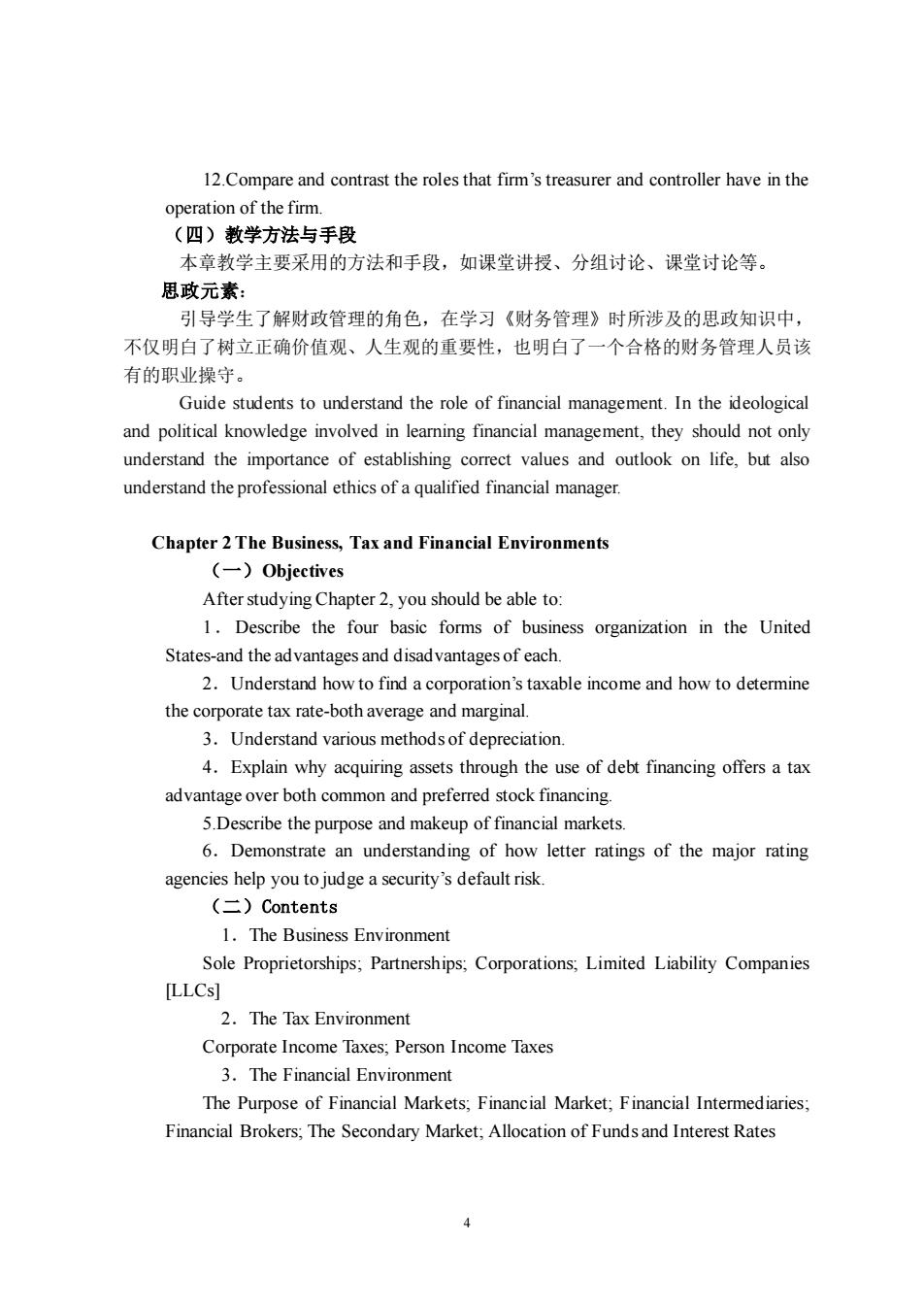
12.Compare and contrast the roles that firm's treasurer and controller have in the operation of the firm. (四)教学方法与手段 本章教学主要采用的方法和手段,如课堂讲授、分组讨论、课堂讨论等, 思政元素: 引导学生了解财政管理的角色,在学习《财务管理》时所涉及的思政知识中, 不仅明白了树立正确价值观、人生观的重要性,也明白了一个合格的财务管理人员该 有的职业操守。 Guide students to understand the role of financial management.In the ideological and political knowledge involved in learning financial management,they should not only understand the importance of establishing correct values and outlook on life.but also understand the professional ethics of a qualified financial manager. Chapter 2 The Business,Tax and Financial Environments (一)Objectives After studying Chapter 2,you should be able to: 1.Describe the four basic forms of business organization in the United States-and the advantages and disadvantages of each. 2.Understand how to find a corporation's taxable income and how to determine the corporate tax rate-both average and marginal. 3.Understand various methodsof depreciation 4.Explain why acquiring assets through the use of debt financing offers a tax advantage over both common and preferred stock financing. 5.Describe the purpose and makeup of financial markets. 6.Demonstrate an understanding of how letter ratings of the major rating agencies help you to judge a security's default risk. (二)Contents 1.The Business environment Sole Proprietorships;Partnerships;Corporations;Limited Liability Companies [LLCs] 2.The Tax Environment Corporate Income Taxes;Person Income Taxes 3.The Financial Environment The Purpose of Financial Markets;Financial Market;Financial Intermediaries Financial Brokers:The Secondary Market:Allocation of Funds and Interest Rates 4
4 12.Compare and contrast the roles that firm’s treasurer and controller have in the operation of the firm. (四)教学方法与手段 本章教学主要采用的方法和手段,如课堂讲授、分组讨论、课堂讨论等。 思政元素: 引导学生了解财政管理的角色,在学习《财务管理》时所涉及的思政知识中, 不仅明白了树立正确价值观、人生观的重要性,也明白了一个合格的财务管理人员该 有的职业操守。 Guide students to understand the role of financial management. In the ideological and political knowledge involved in learning financial management, they should not only understand the importance of establishing correct values and outlook on life, but also understand the professional ethics of a qualified financial manager. Chapter 2 The Business, Tax and Financial Environments (一)Objectives After studying Chapter 2, you should be able to: 1.Describe the four basic forms of business organization in the United States-and the advantages and disadvantages of each. 2.Understand how to find a corporation’s taxable income and how to determine the corporate tax rate-both average and marginal. 3.Understand various methods of depreciation. 4.Explain why acquiring assets through the use of debt financing offers a tax advantage over both common and preferred stock financing. 5.Describe the purpose and makeup of financial markets. 6.Demonstrate an understanding of how letter ratings of the major rating agencies help you to judge a security’s default risk. (二)Contents 1.The Business Environment Sole Proprietorships; Partnerships; Corporations; Limited Liability Companies [LLCs] 2.The Tax Environment Corporate Income Taxes; Person Income Taxes 3.The Financial Environment The Purpose of Financial Markets; Financial Market; Financial Intermediaries; Financial Brokers; The Secondary Market; Allocation of Funds and Interest Rates
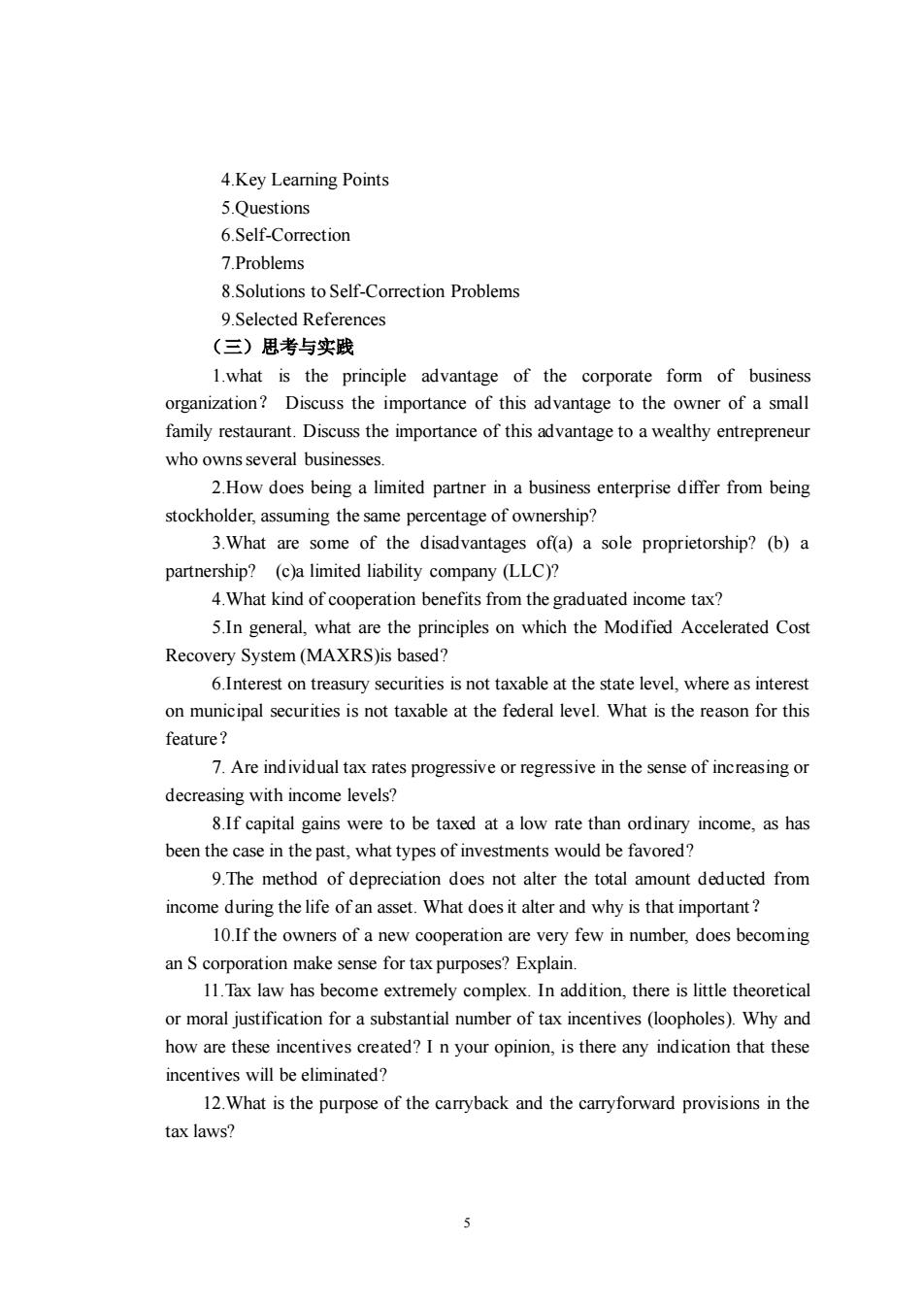
4.Key Learning Points 5.Questions 6.Self-Correction 7.Problems 8.Solutions to Self-Correction Problems 9.Selected References (三)思考与实践 1.what is the principle advantage of the corporate form of business organization?Discuss the importance of this advantage to the owner of a small family restaurant.Discuss the importance of this advantage to a wealthy entrepreneur who owns several businesses 2.How does being a limited partner in a business enterprise differ from being stockholder,assuming the same percentage of ownership? 3.What are some of the disadvantages of(a)a sole proprietorship?(b)a partnership?(ca limited liability company(LLC)? 4.What kind of cooperation benefits from the graduated income tax? 5.In general,what are the principles on which the Modified Accelerated Cost Recovery System(MAXRS)is based? 6.Interest on treasury securities is not taxable at the state level,where as interest on municipal securities is not taxable at the federal level.What is the reason for this feature? 7.Are individual tax rates progressive or regressive in the sense of increasingor decreasing with income levels? 8.If capital gains were to be taxed at a low rate than ordinary income.as has been the case in the past,what types of investments would be favored? 9.The method of depreciation does not alter the total amount deducted from income during the life of an asset.What does it alter and why is that important? 10.If the owners of a new cooperation are very few in number,does becoming an S corporation make sense for tax purposes?Explain. 11.Tax law has become extremely complex.In addition,there is little theoretical or moral justification for a substantial number of tax incentives (loopholes).Why and how are these incentives created?In your opinion,is there any indication that these incentives will be eliminated? 12.What is the purpose of the carryback and the carryforward provisions in the tax laws? 5
5 4.Key Learning Points 5.Questions 6.Self-Correction 7.Problems 8.Solutions to Self-Correction Problems 9.Selected References (三)思考与实践 1.what is the principle advantage of the corporate form of business organization? Discuss the importance of this advantage to the owner of a small family restaurant. Discuss the importance of this advantage to a wealthy entrepreneur who owns several businesses. 2.How does being a limited partner in a business enterprise differ from being stockholder, assuming the same percentage of ownership? 3.What are some of the disadvantages of(a) a sole proprietorship? (b) a partnership? (c)a limited liability company (LLC)? 4.What kind of cooperation benefits from the graduated income tax? 5.In general, what are the principles on which the Modified Accelerated Cost Recovery System (MAXRS)is based? 6.Interest on treasury securities is not taxable at the state level, where as interest on municipal securities is not taxable at the federal level. What is the reason for this feature? 7. Are individual tax rates progressive or regressive in the sense of increasing or decreasing with income levels? 8.If capital gains were to be taxed at a low rate than ordinary income, as has been the case in the past, what types of investments would be favored? 9.The method of depreciation does not alter the total amount deducted from income during the life of an asset. What does it alter and why is that important? 10.If the owners of a new cooperation are very few in number, does becoming an S corporation make sense for tax purposes? Explain. 11.Tax law has become extremely complex. In addition, there is little theoretical or moral justification for a substantial number of tax incentives (loopholes). Why and how are these incentives created? I n your opinion, is there any indication that these incentives will be eliminated? 12.What is the purpose of the carryback and the carryforward provisions in the tax laws?